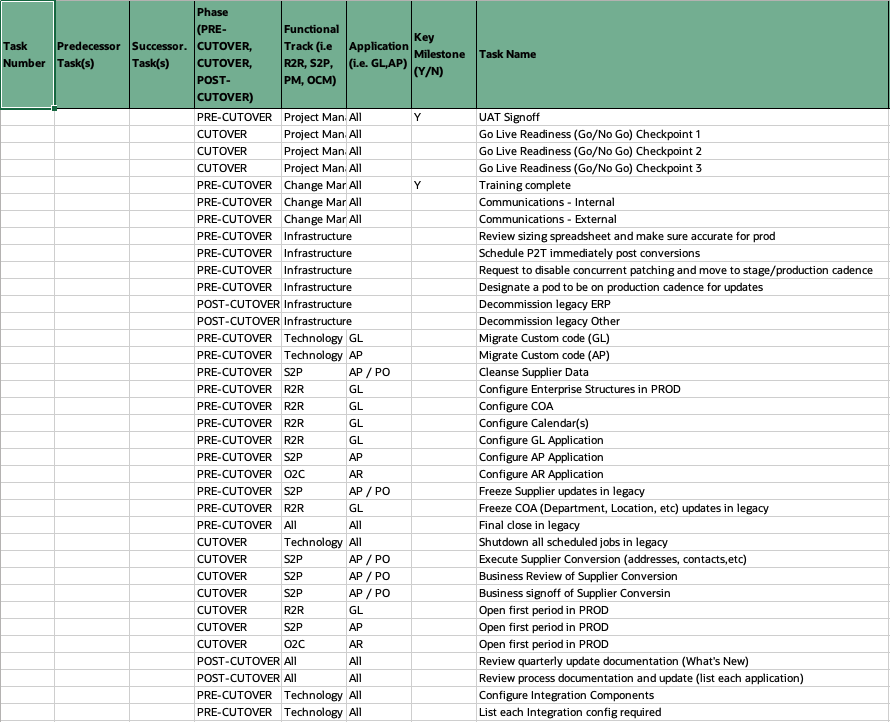This blog post covers the basic concepts of cutover planning for your Oracle Cloud journey.
A cutover plan is very simply the list of tasks that focuses on transitioning from the old system to the new system. This should include a series of steps that must be planned, executed, and monitored to ensure successful deployment.
In addition to a cutover plan, you may create a cutover strategy early in the project. The strategy will identify the ‘how’ you will do various activities within the cutover plan. For example, how will you manage the exchange of systems, is there a roll back plan, is there an interim process, how long can users not have access to the system?
The cutover process is critical for successful deployment of your solution. This plan will detail steps to execute in a particular sequence with minimal downtime and seamless handovers to ensure a smooth process.
Most companies will want to reduce their overall downtime during this transition process (also called ‘blackout’). This will require detailed management of all steps involved to ensure each task is completed and a seamless handover to perform the next task.
Projects should begin tracking cutover tasks as early as configuration and testing. You may find a configuration that changes based upon testing results or additional profiles to set because of testing. Call out these findings identified during this time and include them in the detailed plan.
Communication is critical during the cutover process. It is common to host a ‘war room’ or open conference call where participants can go for help or to transition a task to complete and hand over to the next task/person.
Components of a cutover plan
A cutover plan is a single comprehensive document that details all aspects of the business change that is about to occur. The plan breaks down the ‘type’ of work as well as the attributes of each task in the plan.
Include the following type(s) of work in the cutover plan
Your cutover plan should be a comprehensive list of tasks to complete as part of this process. Include tasks relating to all these areas:
- project management
- change management
- infrastructure
- code migrations
- data conversions
- application configuration
- business tasks (reconciliation, posting, opening of periods, etc)
This document will include all pre-cutover activities, cutover and some post cutover tasks. The cutover plan should also include a series of Go/No Go decision checkpoints with leadership.
Here is an example of tasks to include in your cutover plan:

Include the following attributes for each task
A cutover plan should have at a minimum the following details:
- Task number
- Dependencies (predecessor/successor tasks)
- Phase (pre cutover, cutover, post cutover)
- Track
- Application
- Milestone flag (Y/N)
- Task name
- Primary resource Owner (and executor if different)
- Backup resource owner (if owner is unavailable for some reason)
- Status (% complete)
- Durations
- Planned start/end
- Actual start/end
- Notes
Your cutover plan may look like this:

If your project includes multiple disciplines, i.e. ERP, HCM, SCM all going live at the same time, make sure to create a comprehensive cutover plan that includes dependencies across teams.
If your project is a phased implementation, make sure the tasks you are completing in the production environment, do not impact the applications or businesses that are live.
Cutover Planning Best Practices?
There are many things to consider during the cutover process. Here are many best practices to help you be successful:
- Assign a cutover lead early in the project.
- A cutover lead should be familiar with the project and understand the complexities of the plan they will manage.
- Planning should start early.
- A minimum three months before cutover. However, the earlier you begin cutover planning, the less you will forget to include and your chances for success increase.
- You cannot have too much detail. Consider listing every task and every handover. You cannot over-plan your cutover process.
- Include the smallest reminders, configurations, etc in your plan.
- Test your deployment plan.
- Running through your deployment plan will help to identify issues and areas to streamline further. Maybe you will find that you can convert master data before your blackout period, or that you are more successful running certain conversions sequentially and not in parallel. You will find this out during your testing.
- Spreadsheets are a tool for cutover planning.
- This is the easiest tool to create a cutover plan. The ability to sort, filter and quickly share updates is critical to the process.
- Identify blackout periods and communicate as early as possible (both internal and external).
- Agree proposed downtime with business leadership and communicate both internally and externally. For example, if you are not going to pay suppliers for a few days, you will want to share that information. Same concept for customers and invoicing.
- Identify tasks that can execute early.
- As you test your process, can you pull tasks forward and out of the blackout period that will have minimal impact? The more tasks that are done ahead of time and out of this period, the shorter the blackout period.
Conclusion
By creating a detailed cutover plan, you are providing visibility and a means for open communication during a complex time on a project. Cutover plans are used to:
- reduce risk and ensure clean hand offs,
- reduce end user downtime,
- streamline all the tasks and people involved.
All contributing to a more successful implementation.
